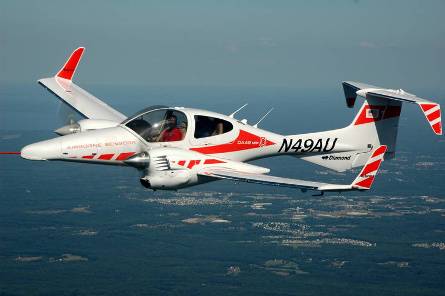Virginia-based aerospace company Aurora Flight Sciences is currently conducting tests on an aircraft meant to bring the best of manned and unmanned flight together in one platform.
The Centaur optionally piloted aircraft (OPA) prototype tests will characterise the airframe and power plant so the flight control system can be programmed appropriately for converting the Diamond 42M general aviation aircraft for unmanned use.
The combination of advanced avionics, efficient diesel engines and fully composite structure make the DA-42M a solid platform for intelligence, surveillance and reconnaissance (ISR) flights. Centaur will support most commercial and military electro-optical and communication payloads with nose and belly pod modifications.
Aurora will wrap the flight control system into an auto pilot package in August, says Martin Gomez, Aurora's aerial robotics group manager. In September, the team will install it to fly with a human "safety pilot" on board before beginning a "lengthy period of testing that will probably take us through the winter," Gomez says. From there, Centaur will head into restricted airspace for fully unmanned testing.
 |
|---|
| © Aurora Flight Sciences |
Aurora has already built the flight control system, which was adapted from other systems, Gomez says. "This is not our first UAV," he says.
The company has been in the unmanned aircraft business for more than 20 years and its work includes a line of small vertical take-off unmanned aircraft system (UAS) called GoldenEye. Aurora also builds composite fuselage components and tail assemblies for the Northrop Grumman RQ-4 Global Hawk.
With Centaur, Aurora's Centaur plans to offer the best of both worlds: a low-cost, reliable general aviation ISR aircraft that can be converted for unmanned flight in as little as 4hr, the company estimates. Centaur's OPA kit will allow operators to fly like any normal aircraft for missions or repositioning, and convert it to an unmanned mode on site -- essentially exit the aircraft, change its mode, operate it from a laptop control station unmanned, and reverse the process once the mission is complete.
"We had a lot of the technological chunks that we needed to make this happen," Gomez says. Aurora flew a Cessna 337 in a similar - but not fully unmanned - configuration last summer. The work in building an OPA, he says, comes in devising ways to automatically complete simple tasks that a human in the cockpit usually does, such as starting the engine and retracting the landing gear. Using a proven airframe with a US Federal Aviation Administration-approved flight manual helps in the decision-making process, Gomez says.
"It saves a lot of non-recurring engineering if you start with a known, good airframe," he says. Aurora selected the DA-42M in large part because of Diamond's new production line, stable supply chain and a good relationship between the companies, Gomez says. "There are not that many light twins in current production," he says. "You don't want to send the customer a modified 20- or 30-year-old airplane." The engines were also appealing, he says, as military customers want to use heavy-fuel aircraft.
The Centaur is being built with a customer in mind, says Gomez, though he refused to elaborate. There are plenty who can't live with just UAS or just manned aircraft, he says. "I think there's a lot of reasons why customers are going to want the flexibility that an OPA can offer."
Source: Flight International























